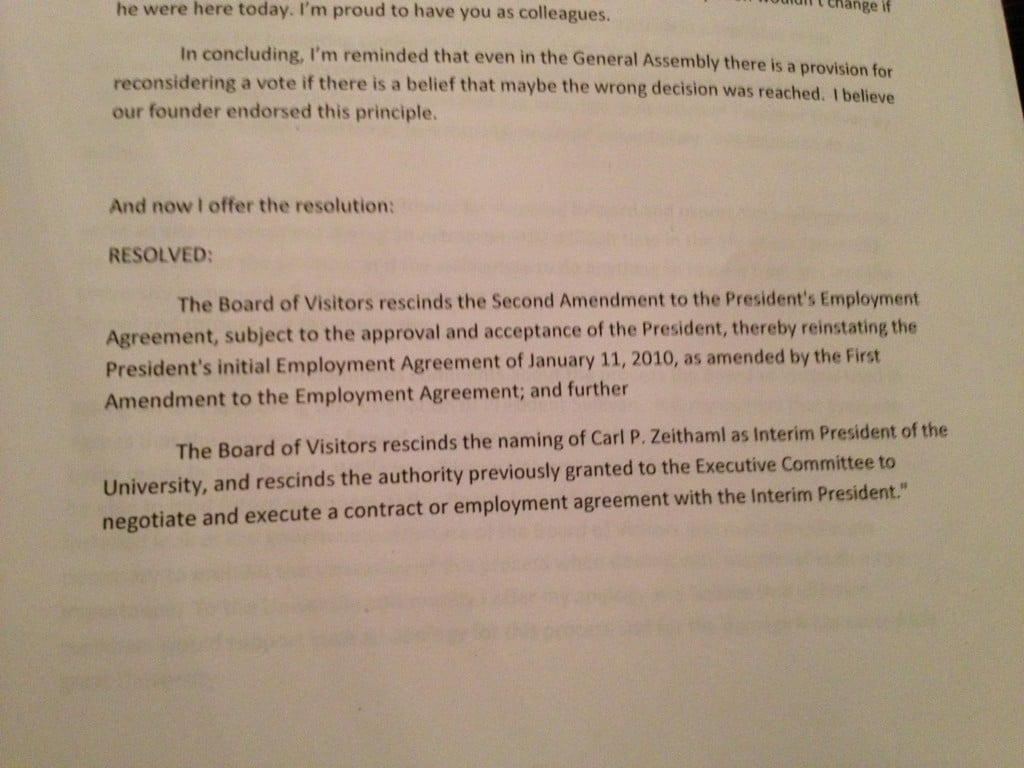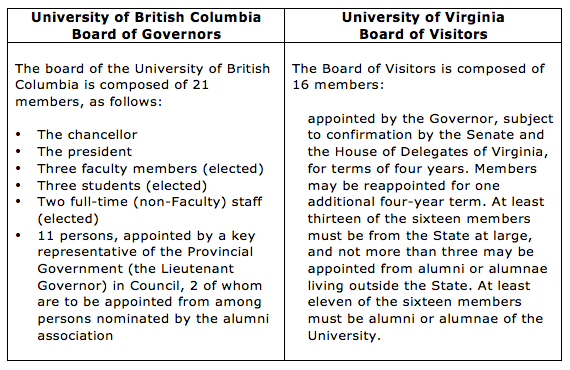You have /5 articles left.
Sign up for a free account or log in.
 Well, the University of Virginia's Board of Visitors has just voted to rescind their 10 June decision to end President Teresa Sullivan's employment contract. A photograph of the actual resolution is pasted in to the right, and was sourced here.
Well, the University of Virginia's Board of Visitors has just voted to rescind their 10 June decision to end President Teresa Sullivan's employment contract. A photograph of the actual resolution is pasted in to the right, and was sourced here.
There will be, no doubt, much analysis of the decision-making procedures that led to this debacle in university governance, as well as on the structural conditions generating unease in public higher education, especially with respect to world class 'flagship' universities. See today's op-ed, for example, by Jeff Selingo in the New York Times.
The question I'd like to pose is this: what is the most appropriate composition of university governing boards, not just for deliberating about moving forward, but also making potentially high risk decisions regarding policy setting, goal making, overall budgeting, and the hiring and firing of senior leaders? Of course, as noted in today's meeting in Virginia, decision-making needed to be more strategic and transparent. But who is making the decisions, and is the overall composition of the unit making the decisions optimally configured for the 21st century higher ed landscape?
Now this is an issue I flagged in 'On the Failure of Legacy Governance at the University of Virginia,' an entry that generated more traffic than any other entry posted in the history of GlobalHigherEd. To push this issue a little further, what I'd like to do here is post, side by side, information about the nature of the boards of the University of Virginia (UVa) and the University of British Columbia (UBC), two world class universities that are members of the same university consortia (Universitas 21). In terms of respective world university rankings:
- UBC is 22 and UVa is 135 in the Times Higher Education/Thomson Reuters ranking (2010-2011)
- UBC is 36 and UVa is 96 in the Academic Ranking of World Universities (2010)
Link here to see more about the backgrounds of the current University of British Columbia Board members.
Link here to see more about the backgrounds of the current University of Virginia Board members.
Ask yourself this: which board composition is better placed to understand the context in which policy- and goal-making occurs, budgets can be transformed, and leadership decisions should be considered in? When doing so, though, factor in what UW-Madison's former chancellor said in today's New York Times:
“Everybody thinks university presidents are hierarchical and top-down,” said Donna E. Shalala, president of the University of Miami, and a former chancellor of the University of Wisconsin and secretary of health and human services. “But we are not corporate chieftains, and we cannot rule from the sky. We are more like tugboat captains, trying to get our ships aligned and pulling them in the right direction.”
The great research universities, she said, have achieved their dominant position in the world through shared faculty governance, and leaving faculty both academic and research freedom.
“It was a lot easier to run a cabinet department than the University of Wisconsin,” Ms. Shalala said. “There are a lot of different constituencies at a university, and the president cannot be successful without buy-in from all of them.”
As is evident in Virginia, there may be pressures, crises, opportunities, and constraints, but it is simply foolhardy to assume governance systems can and should exclude those being governed, not to mention those being served (including significant student representation given fast rising proportions of revenue via tuition fees). Like it or not, only shared governance and "a diversity of backgrounds" at the university board level, will enhance understandings of organizational dynamics in universities, and enable ideas floated in board contexts to be critically evaluated before decisions occur.
In the end, don't we need board level policy- and goal-making to occur in a manner than enables realistic and scalable innovation to occur? Wishful or naïve thinking, or even worse loading boards with people who have donated monies to government leaders, cannot but be a recipe for disaster. Legacy-based university governance has a multitude of weaknesses, and we ignore this fact at our peril.






